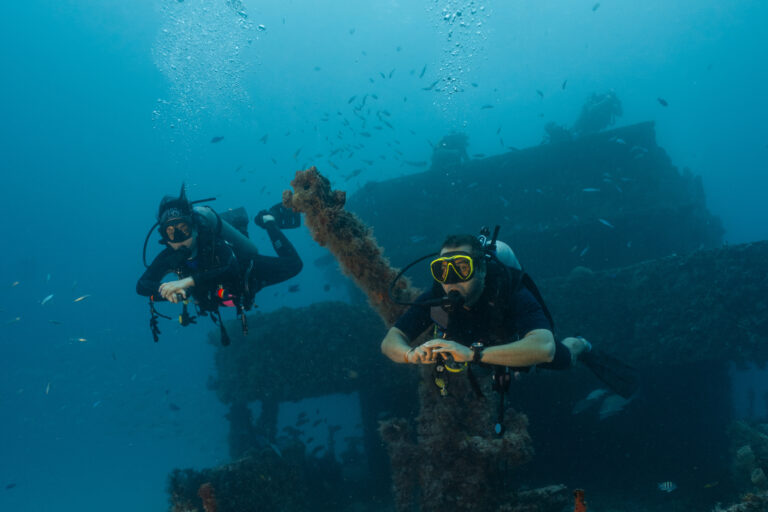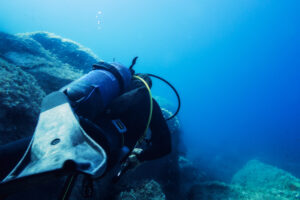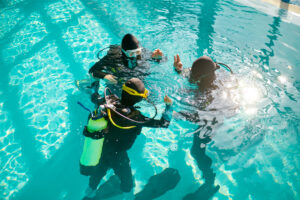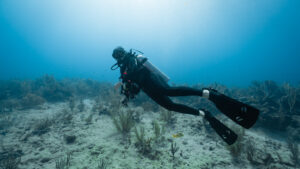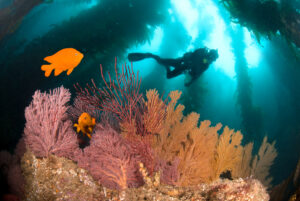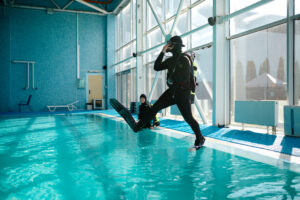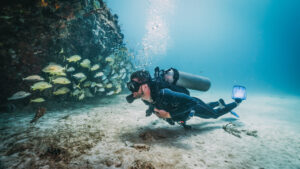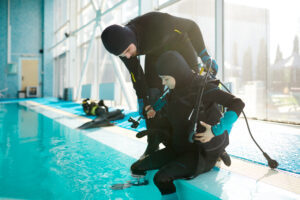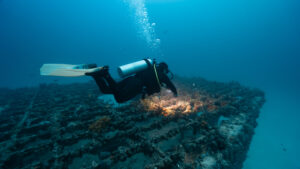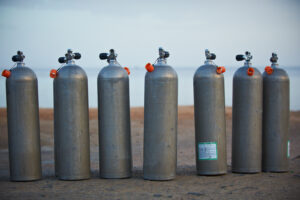What is a Deco Mix?
Decompression mix, or deco mix, is a specialized gas mixture used in scuba diving to facilitate safer and more efficient decompression during ascent. Decompression is a critical phase in diving where accumulated inert gases, primarily nitrogen, are safely expelled from a diver’s body to avoid decompression sickness (DCS). Deco mixes are tailored to optimize the elimination of these gases, particularly during deep or prolonged dives where standard air might not suffice. Understanding and correctly using deco mixes can significantly enhance a diver’s safety, reducing the risk of DCS and other diving-related ailments.
Basics of Decompression Mix
A decompression mix, often abbreviated as deco mix, is a gas blend used by divers to manage their decompression stops more effectively. These mixes typically contain higher concentrations of oxygen and sometimes include inert gases like helium. The primary goal of using a deco mix is to accelerate the off-gassing process, allowing nitrogen to be expelled from the body tissues more rapidly and safely than with regular air.
The importance of deco mixes stems from their ability to lower the risk of decompression sickness, a condition caused by inert gas bubbles forming in the bloodstream and tissues during rapid ascent. By using a gas mix with a higher oxygen content, the partial pressure of nitrogen is reduced, thereby enhancing its elimination from the body. This controlled off-gassing process is vital for divers who engage in technical, deep, or long-duration dives, where the risk of DCS is inherently higher.
Understanding the composition and purpose of different deco mixes is essential for divers. Deco mixes vary in their ratios of oxygen, nitrogen, and sometimes helium, each designed for specific diving conditions and depths. Proper training and familiarity with these mixes are crucial, as incorrect use can lead to serious health risks, including oxygen toxicity or insufficient decompression.
Types of Deco Mixes
Deco mixes come in various formulations, each tailored to specific diving requirements and depths. Three primary types of gas mixes are commonly used in decompression diving: Nitrox, Trimix, and Heliox.
Nitrox, also known as enriched air, is perhaps the most widely used deco mix among recreational and technical divers. It contains a higher percentage of oxygen (typically between 32% and 40%) compared to atmospheric air, which has about 21% oxygen. By increasing the oxygen content, Nitrox reduces the proportion of nitrogen in the gas mix, thus minimizing nitrogen absorption and the risk of decompression sickness. Nitrox is particularly beneficial for dives within the 30-meter (98.4 feet) range, where it allows for extended bottom times and shorter decompression stops.
Trimix is a more complex deco mix that includes helium in addition to oxygen and nitrogen. This blend is used for deeper dives, often beyond the 60-meter (196.8 feet) mark. Helium, being less narcotic than nitrogen, helps mitigate the effects of nitrogen narcosis, a condition that impairs cognitive function at great depths. By adjusting the ratios of oxygen, nitrogen, and helium, divers can create a Trimix blend that suits the specific depth and duration of their dive, enhancing safety and performance.
Heliox is a mixture of helium and oxygen, with no nitrogen content. This gas blend is primarily used for very deep commercial or technical dives, often exceeding 100 meters (328 feet). Heliox is effective in eliminating both nitrogen narcosis and oxygen toxicity risks at extreme depths. However, the absence of nitrogen requires careful management of the oxygen concentration to avoid hypoxia or oxygen toxicity, particularly during ascent and decompression stops.
Each type of deco mix has its unique advantages and applications, making them indispensable tools for divers operating in various underwater environments. Selecting the appropriate mix involves careful consideration of dive profiles, depth, and individual diver physiology.
Physiological Effects of Deco Mixes
Understanding the physiological effects of deco mixes is crucial for safe diving practices. These gas blends influence how gases are absorbed and eliminated by the body, impacting decompression efficiency and the overall health of the diver.
When a diver breathes a deco mix, the higher oxygen content facilitates more effective elimination of inert gases, particularly nitrogen. This process is known as off-gassing. During a dive, the body absorbs nitrogen from the breathing gas, and the amount of nitrogen dissolved in the tissues increases with depth and duration. As the diver ascends, the pressure decreases, and nitrogen begins to come out of solution, forming bubbles if not managed correctly. Deco mixes help to control this process, ensuring a safer ascent by promoting the expulsion of nitrogen at a controlled rate.
Nitrox, for example, with its elevated oxygen levels, reduces the partial pressure of nitrogen in the breathing mix. This reduction means that less nitrogen is absorbed by the body’s tissues during the dive. Consequently, during ascent, there is less nitrogen to off-gas, reducing the risk of decompression sickness. However, the higher oxygen concentration also means that divers must be wary of oxygen toxicity, particularly at greater depths where the partial pressure of oxygen can reach dangerous levels.
Trimix and Heliox address the issue of nitrogen narcosis and oxygen toxicity in deep dives. Helium, a non-narcotic gas, replaces some or all of the nitrogen, allowing divers to function more effectively at depths where nitrogen would impair cognitive abilities. The lower density of helium also reduces breathing resistance, making it easier to breathe under high-pressure conditions. However, managing oxygen levels in these mixes is critical to prevent hypoxia or oxygen toxicity, especially during prolonged decompression stops.
The physiological impact of using deco mixes extends beyond just gas absorption and elimination. These mixes also influence factors such as thermal conductivity and breathing resistance. Helium, for example, conducts heat away from the body more efficiently than nitrogen, which can lead to increased heat loss and a higher risk of hypothermia in cold water dives. Divers using helium-based mixes need to be adequately insulated to maintain body temperature and prevent cold-related issues.
Planning and Calculating Deco Mixes
Effective planning and precise calculation of deco mixes are fundamental aspects of technical diving. Divers must use decompression software and tables to design safe dive profiles that incorporate appropriate deco mixes for their planned depth and duration.
The first step in planning a dive with deco mixes is to determine the dive’s maximum depth and bottom time. These parameters dictate the type of deco mix required and the number of decompression stops needed during ascent. Divers use decompression software, which integrates algorithms based on established decompression models, to calculate the optimal gas mixtures and decompression schedule.
For instance, a diver planning a 60-meter (196.8 feet) dive might select a Trimix blend with a specific ratio of oxygen, nitrogen, and helium. The software will calculate the necessary decompression stops, the duration of each stop, and the gas mix required at each stage of the ascent. The diver must follow this plan meticulously to ensure all inert gases are safely expelled from the body.
Calculating the gas mix involves understanding partial pressures and gas absorption rates. Divers must ensure that the partial pressure of oxygen remains within safe limits to avoid oxygen toxicity, particularly at greater depths. For example, an oxygen partial pressure of 1.4 ATA is considered safe for the working phase of the dive, while a partial pressure of 1.6 ATA is acceptable for decompression stops. The software helps divers adjust their gas blends to maintain these limits.
In addition to software, divers often use decompression tables as a reference. These tables provide guidelines on the required deco stops based on the depth and time of the dive. While less flexible than software, tables are a valuable backup tool for planning and executing dives with deco mixes.
A critical aspect of planning is ensuring an adequate gas supply for the entire dive, including contingencies for emergencies. Divers must calculate the volume of each gas mix required and verify that their tanks can accommodate these volumes. Redundancy is vital, with additional tanks or rebreathers used to ensure a continuous supply of the correct gas mix throughout the dive.
Overall, meticulous planning and calculation are essential for using deco mixes safely. Divers must combine theoretical knowledge with practical experience, relying on accurate tools and methods to manage their decompression effectively.
Practical Applications in Diving
The practical applications of deco mixes are evident in various diving scenarios, particularly in technical, deep, and commercial diving. These gas blends enable divers to undertake complex and extended dives that would be impossible with standard air, enhancing both safety and performance.
In technical diving, deco mixes are indispensable for exploring deeper underwater environments. Technical divers often operate beyond recreational diving limits, encountering depths where nitrogen narcosis and oxygen toxicity become significant risks. Using Trimix or Heliox allows these divers to mitigate these risks, maintaining cognitive function and physiological safety at greater depths. For example, a technical diver exploring a wreck at 80 meters (262.5 feet) would use a Trimix blend to reduce nitrogen narcosis and manage oxygen levels, ensuring a safe and effective dive.
Commercial diving, which involves underwater construction, maintenance, and salvage operations, also relies heavily on deco mixes. These divers often work at considerable depths for extended periods, necessitating precise decompression protocols. Heliox is commonly used in commercial diving to enable work at extreme depths while minimizing the risks associated with nitrogen and oxygen. This application is critical in industries such as offshore oil and gas, where divers might work on underwater pipelines or platforms at depths exceeding 100 meters (328 feet).
Case studies highlight the importance of deco mixes in real-world diving scenarios. One notable example is the exploration of the Andrea Doria wreck, located off the coast of Nantucket, Massachusetts, at a depth of approximately 70 meters (229.6 feet). Divers use Trimix to explore the wreck safely, as the depth and extended bottom times require careful management of nitrogen absorption and oxygen toxicity. These expeditions demonstrate how deco mixes enable divers to reach and study underwater sites that would otherwise be inaccessible.
Special considerations are necessary for deep dives, where deco mixes must be tailored to the specific depth and duration of the dive. The increased complexity of gas management at these depths requires rigorous training and experience. Divers must be proficient in using
rebreathers and multiple gas cylinders, switching between mixes at various stages of the dive to optimize decompression and ensure safety.
In conclusion, the practical applications of deco mixes are vast, enabling divers to safely and effectively conduct deep and technical dives. These gas blends expand the possibilities of underwater exploration and commercial operations, highlighting the critical role of deco mixes in modern diving practices.
Safety Considerations and Best Practices
Safety is paramount when using deco mixes, as the incorrect application of these gas blends can lead to severe health risks, including decompression sickness, oxygen toxicity, and nitrogen narcosis. Divers must adhere to strict safety protocols and best practices to mitigate these risks and ensure a successful dive.
One of the primary safety considerations is the accurate mixing and analysis of deco gases. Divers should use precision equipment to blend their gas mixes, ensuring the correct proportions of oxygen, nitrogen, and helium. After mixing, each gas cylinder must be analyzed to verify its composition before the dive. This step is crucial to prevent any deviations from the planned gas mix, which could result in dangerous physiological effects during the dive.
Proper training and certification are essential for divers using deco mixes. Technical diving courses provide comprehensive instruction on gas blending, decompression theory, and the use of advanced diving equipment. Divers learn how to plan and execute dives with multiple gas switches, manage decompression stops, and handle emergencies. Certification from recognized diving organizations ensures that divers have the necessary skills and knowledge to use deco mixes safely.
Monitoring physiological responses during the dive is another critical aspect of safety. Divers should be aware of the signs and symptoms of nitrogen narcosis, oxygen toxicity, and decompression sickness. Recognizing these signs early allows for prompt intervention, such as adjusting the ascent rate or switching to a different gas mix. Continuous monitoring of depth, time, and gas consumption is also essential to adhere to the planned dive profile and avoid exceeding safe limits.
Redundancy in equipment is a key safety practice. Divers should carry backup gas supplies and use redundant systems for critical components like regulators and dive computers. This redundancy ensures that any equipment failure can be managed without compromising safety. Rebreathers, which recycle exhaled gas and add the necessary oxygen, are commonly used in technical diving for their efficiency and ability to extend dive times. However, rebreathers also require thorough training and meticulous maintenance to prevent malfunctions.
Emergency procedures must be clearly defined and practiced regularly. Divers should have a contingency plan for various scenarios, such as gas supply issues, equipment failure, or sudden onset of symptoms related to decompression sickness. Practicing these procedures ensures that divers can respond quickly and effectively to any emergency, minimizing the potential for serious injury.
The safe use of deco mixes involves precise gas blending, rigorous training, continuous monitoring, redundancy in equipment, and well-defined emergency procedures. Adhering to these best practices allows divers to utilize deco mixes effectively, enhancing both safety and performance in deep and technical diving scenarios.
Key Takeaways
Deco mixes play a critical role in modern diving, enabling safer and more efficient decompression during deep and technical dives. Understanding the different types of deco mixes, their physiological effects, and the importance of meticulous planning and safety protocols is essential for divers. Proper training, accurate gas blending, continuous monitoring, and well-practiced emergency procedures ensure that deco mixes can be used effectively, reducing the risk of decompression sickness and other diving-related health issues. Through these practices, divers can safely explore greater depths and undertake more complex underwater tasks, expanding the possibilities of underwater exploration and commercial diving operations.

